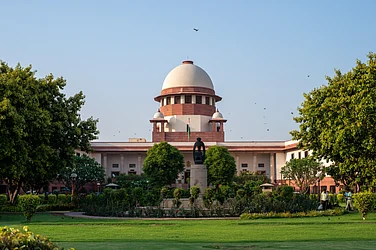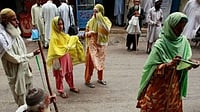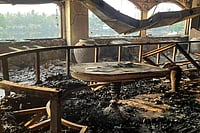As the Women's Reservation Bill has already been tabled and the debates over equal representation are gaining ground, one can't help but look at the early days of Panchayati Raj system that introduced the idea of gender-based representation in the lower-rung of the administration.
In the late 1980s, the then-Prime Minister Rajiv Gandhi made Panchayati Raj system his top priority. His focus on the decentralisation of power was carried on by P V Narasimha Rao and through the 73rd constitutional amendment on April 24, 1993, women were given one-third reservation in the Panchayat system.
It also mandated that "one-third of the total number of seats reserved" must be set aside for women from the Scheduled Castes or, when applicable, the Scheduled Tribes. Furthermore, it stipulated that "no less than one-third (including seats reserved for women from the Scheduled Castes and Scheduled Tribes) of the total number of seats to be filled through direct elections in every panchayat should be reserved for women, and these seats may be allocated to different constituencies within a panchayat on a rotational basis."
In India, 21 states have implemented a policy of reserving 50% of seats for women in Panchayati Raj Institutions (PRIs). As of 2020, over 46% of the members in these Panchayati Institutions are women.
According to a study conducted by the Gokhale Institute of Political and Economics based in Pune, a striking 86% of the women surveyed mentioned that they contested in Panchayat and Zilla Parishad elections primarily because the seats were reserved for female candidates.
The 1992 amendment proved to be a catalyst, resulting in the elevation of over 14.5 lakh women to leadership positions in India's local governance. Presently, as many as 20 states—Andhra Pradesh, Assam, Bihar, Chhattisgarh, Gujarat, Himachal Pradesh, Jharkhand, Karnataka, Kerala, Madhya Pradesh, Maharashtra, Odisha, Punjab, Rajasthan, Sikkim, Tamil Nadu, Telangana, Tripura, Uttarakhand, and West Bengal—have implemented a 50% reservation for women in their Panchayati Raj Institutions (PRIs). In fact, several states, like Karnataka, even exceeded the 50% mark in terms of women representatives in PRIs, indicating that women are now succeeding in winning seats in areas that were not specifically reserved for them.
Women reservation in PRI: Still and obstacle for many
The prevailing patriarchal system continues to cast a shadow over India's political landscape. Although laws have been enacted to ensure equal representation of women in politics, particularly in panchayat elections, women often find themselves as figureheads with limited real authority. Numerous obstacles hinder women's participation in Panchayati elections, including deeply ingrained patriarchal mindsets that lead women to function as proxies for their male family members. Furthermore, even women within the system sometimes encounter insensitivity from their male colleagues.
Tragically, women frequently face the threat of violence from powerful elements of society if they make bold decisions or assert their authority. Recent reports have highlighted instances in which husbands or male family members have taken the oath of office instead of the duly elected women representatives in newly formed Madhya Pradesh panchayats. Such occurrences blatantly contravene established rules and are a direct mockery of the principles of constitutional democracy. In this context, efforts to empower women at the grassroots level appear to be an uphill battle.
Panchayats working well under women leadership
The impact of women's participation in provincial politics is perhaps most notable for debunking prevailing social myths. Initially, there were people who doubted the inclusion of women in positions of power, asserting that women would merely serve as figureheads for their husbands. They believed that women would struggle to wield administrative power either due to their own lack of knowledge or the constraints imposed by their domestic responsibilities. Even in states like West Bengal and Kerala, where grassroots political engagement was already prevalent, there was a prevailing perception that women would be relegated to the role of passive observers or mere rubber stamps in decision-making.
However, wherever women have assumed positions of power, noticeable changes have been observed. Many panchayats have demonstrated effective performance despite financial constraints. On average, each gram panchayat receives approximately Rs 200 per person for undertaking village development work. This amount varies across states, with allocations such as Rs 1.5 lakh per gram panchayat in Haryana, Rs 2.3 lakh in Himachal Pradesh, Rs 90,000 in Uttar Pradesh, Rs 6.5 lakh in Madhya Pradesh, and Rs 66 lakh in Kerala.
As women's participation in panchayats gradually starts to influence grassroots governance positively, it lays the foundation for extending this social revolution to decision-making at all levels. Currently, women occupy only 6.7% of the total seats in Parliament. The lessons and successes emerging from women-led panchayats should hopefully contribute to building a consensus in favor of reserving seats for women in Parliament.
As reported by Down To Earth: Saroj Rana, the pioneering first woman pradhan of Siyoni block panchayat in Uttarkashi district, has achieved notable accomplishments during her tenure. She gave a nod to the construction of a school and a road for her block panchayat, marking significant improvements in local infrastructure. What's even more remarkable is that Rana disrupted the long-established tradition in which funds allocated under the Jawahar Rozgar Yojana were handed over to contractors who would construct substandard structures. This practice allowed both the pradhan and the contractor to siphon off a portion of the funds. Rana, however, brought about a transformative change.
A major impact of women on local politics has been the role they have played in controlling the stranglehold of liquor in most village communities. "We have been successful in closing down two thekas (liquor vends) during the last year. Both these thekas were in panchayats led by women. The pradhans were with us in the struggle," says Soma Devi president of the informal federation of mahila mandals in Chamba, Himachal Pradesh. In many states were women led anti-liquor movements, the support for these can be traced back directly to panchayati raj institution where women held key positions.



















_.jpg?w=200&auto=format%2Ccompress&fit=max)






